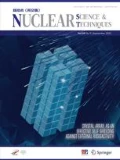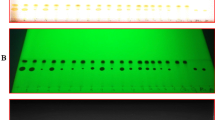Abstract
The method based on solvent parameters (mass, cycle of acidification, and autodeposition time), combined with response surface methodology (RSM) modeling and optimization, has been developed for maximizing 210Po activity in tea samples, as observed by an alpha spectrometer. RSM based on 3-factor and 5-level composite center design was used to obtain the optimal combination of solvent conditions. As solvent parameters for 210Po activity, different masses (0.5, 0.75, 1, 1.5, and 2 g), different cycles of acidification (2, 3, 4, 5, and 6 times), and different autodeposition times (2, 3, 4, 5, and 6 h) were studied. The 3D response surface plot and the contour plot derived from the mathematical models were used to determine the optimal conditions. According to the obtained results, the experimental value of 210Po activity was in good agreement (R2 = 0.96) with the value predicted by the model. We found a favorable effect of mass on the 210Po activity (p < 0.05).






Similar content being viewed by others
References
F.K. Görür, R. Keser, N. Akçay et al., Annual effective dose and concentration levels of gross α and β in Turkish market tea. Int. J. Radiat. Res. 10, 67–72 (2012)
M.G. Shooshtari, M.R. Deevband, M.R. Kardan et al., Analytical study of Ra-226 activity concentration in market consuming foodstuffs of Ramsar, Iran. J. Environ Health Sci. Eng. 15, 1–7 (2017). https://doi.org/10.1186/s40201-017-0281-3
Environmental Protection Agengy (EPA) (2018), http://www.epa.ie/radiation/radexp. Accessed 16 Feb 2018
A.E.M. Khater, Polonium-210 budget in cigarettes. J. Environ. Radioact. 71, 33–41 (2004). https://doi.org/10.1016/S0265-931X(03)00118-8
N.S. Fisher, K.B. Seiller, T.G. Hinton et al., Evaluation of radiation doses and associated risk from the Fukushima nuclear accident to marine biota and human consumers of seafood. Proc. Natl. Acad. Sci. USA 110, 10670–10675 (2013). https://doi.org/10.1073/pnas.1221834110
M. Horvath, A. Shahrokhi, P. Bator et al., Determination of Po-210 content in cigarette smoke using a smoking machine: A case study of Iranian cigarettes. J. Environ. Radioact. 174, 66–70 (2017). https://doi.org/10.1016/j.jenvrad.2017.01.023
E.V. Puchkovaa, O.G. Bogdanova, 210Po in black and green teas. Radiochemistry 58, 98–105 (2016)
M.S. Al-Masri, A. Nashawati, Y. Amin et al., Determination of 210Po in tea, mate and their infusions and its annual intake by Syrians. J. Radioanal. Nucl. Chem. 260, 27–34 (2004)
F.K. Görür, R. Keser, N. Akçay et al., Radionuclides and heavy metals concentrations in Turkish market tea. Food Control 22, 2065–2070 (2011). https://doi.org/10.1016/j.foodcont.2011.06.005
D. Desideri, M.A. Meli, C. Roselli et al., Alpha and gamma spectrometry for determination of natural and artificial radionuclides in tea, herbal tea and camomile marketed in Italy. Microchem. J. 98, 170–175 (2011). https://doi.org/10.1016/j.microc.2011.01.005
D.E. Di Gregorio, H. Huck, R. Aaristegui et al., 137Cs contamination in tea and yerba mate in South America. J. Environ. Radioact. 76, 273–281 (2004). https://doi.org/10.1016/j.jenvrad.2003.11.008
M.C. Cook, M.J. Stukel, W. Zhang et al., The determination of Fukushima-derived cesium-134 and cesium-137 in Japanese green tea samples and their distribution subsequent to simulated beverage preparation. J. Environ. Radioact. 153, 23–30 (2016). https://doi.org/10.1016/j.jenvrad.2015.12.010
N. Fathabadi, A.A. Salehi, K. Naddafi et al., Radioactivity levels in the mostly local foodstuff consumed by residents of the high level natural radiation areas of Ramsar, Iran. J. Environ. Radioact. 169–170, 209–213 (2017). https://doi.org/10.1016/j.jenvrad.2016.12.011
S.F. Mutlu, İki basamaklı tepkime ile sıvı özütlemeli yöntem kullanarak fındık tohum kabuklarından furfural üretimi için en uygun koşulların istatistik yöntem ile belirlenmesi. J. Fac. Eng. Archit. Gazi Univ. 25, 21–26 (2010). (in Turkish)
L.C. Zhao, Y. He, X. Deng et al., Response surface modeling and optimization of accelerated solvent extraction of four lignans from fructus schisandrae. Molecules 17, 3618–3629 (2012). https://doi.org/10.3390/molecules17043618
S. Sharma, A. Malik, S. Satya, Application of response surface methodology (RSM) for optimization of nutrient supplementation for Cr(VI) removal by Aspergillus lentulus AML05. J. Hazard. Mater. 164, 1198 (2009). https://doi.org/10.1016/j.jhazmat.2008.09.030
A. Dean, D. Voss, D.D. Draguljic, Response Surface Methodology, Design and Analysis of Experiments (Springer, New York, 2017). ISBN 978-3-319-52250-0
Author information
Authors and Affiliations
Corresponding author
Rights and permissions
About this article
Cite this article
Çam Kaynar, S., Kaynar, Ü.H. Method for the determination of polonium-210 in tea samples using response surface methodology (RSM). NUCL SCI TECH 30, 45 (2019). https://doi.org/10.1007/s41365-019-0567-5
Received:
Revised:
Accepted:
Published:
DOI: https://doi.org/10.1007/s41365-019-0567-5




